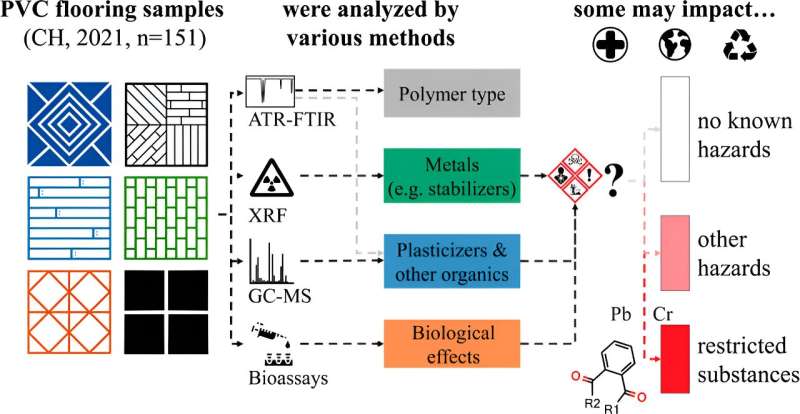This article has been reviewed according to Science X's editorial process and policies. Editors have highlighted the following attributes while ensuring the content's credibility:
fact-checked
peer-reviewed publication
trusted source
proofread
Why recycling plastic is not a quick fix

Considering the climate crisis and worldwide plastic pollution, many people believe that recycling materials, in particular plastic, is the solution to our problems. Recycling can reduce resource use, prevent waste and reduce CO2 emissions. It is an important cornerstone of the circular economy. But while some materials are relatively simple to recycle, recycling plastics involves a complex conflict of objectives.
It is particularly important to recycle fossil-based plastics rather than incinerating them (thermal recycling) or dumping them in the environment after they have been used once. In many municipalities in Switzerland, we can dispose of our plastic waste—or to describe it more accurately, our mixed household plastics—in one of the many collection bags for plastics, so that it can then be sorted by machine and recycled.
However, the recycling process soon reaches its limits. Mechanical recycling is most useful in environmental terms when the recycled material replaces as much primary material as possible. This means that the CO2 emissions from production and incineration can be avoided and the plastic does not make its way into landfill or into the environment. But replacement of new plastics requires high-quality recycled material—and this is precisely where the problem lies.
Chemicals can disrupt the recycling process
It is important to be aware that we produce and use a huge variety of different plastics. They consist of polymer chains that are made up of repeating monomer units and, depending on their intended purpose, contain many additional chemicals, including stabilizers, plasticizers and flame retardants, which give the plastics the necessary properties. In a report for the UN Environment Program, we identified up to 13,000 chemicals used in plastics. Many of these substances are potentially harmful to human health and to the environment. Nevertheless, in some cases they are not adequately regulated.
The huge number of plastics and additives often reduces the quality of the recycled material and, in practice, makes recycling difficult or impossible. As a result, it is not very helpful for us to collect more and more plastic waste if many plastic products cannot be manufactured from the resulting recycled material but only from new materials.
A more serious problem is that long-lasting plastic products often contain additives that we now know are harmful to human health and the environment. If the recycling of these plastics is not carefully managed, it may result in regulated chemicals remaining in circulation for longer, rather than being removed from the cycle.
The downside of our colorful plastic world
In contrast to the case of foods, for example, manufacturers of plastics rarely have to declare their formulations and ingredients. This means that we do not know what most plastic products contain and whether they can be safely recycled. This is where my research comes in. As a chemist, I am attempting to identify what plastics are made of and whether they are recyclable.
For example, as part of a study published in Environmental Science & Technology, we recently worked with colleagues from other Swiss universities to investigate plastic floor coverings made from polyvinyl chloride (PVC). PVC is an important plastic in the construction industry that is often recycled (recycling rate: 16%). In the study, we tested 151 new PVC floorings for heavy metals, plasticizers and other chemicals. All tested products were new and had been purchased in Switzerland.
The results of the study surprised us. In 24 of the new floor coverings (16%), we found harmful additives that had long since been banned, such as lead used as a stabilizer and the plasticizer DEHP, an ortho‑phthalate. The use of both lead and DEHP in new materials was banned in the EU and in Switzerland because of health hazards. The fact that these substances can still be be found in new floor coverings is, in our view, most likely due to contaminated recycled PVC.
Another 29% of the floor coverings contained other ortho‑phthalates as plasticizers that are still authorized for use but are also substances of concern. Some phthalates are suspected of being endocrine-disrupting and carcinogenic and have been linked to a wide variety of medical conditions.
PVC floorings have long since been assumed to be a major source of hazardous chemicals in building interiors because they release plasticisers. Despite this, we know little about their chemical composition.
How can we resolve this problem?
This example shows how the wide variety of different chemicals in plastics and the lack of transparency about them causes problems for the circular economy and potentially puts people and the environment at risk.
In the future, we need to find ways of recycling PVC flooring materials sustainably, without causing harm to human health. This requires stricter controls and processes to remove harmful chemicals from recycled PVC products. Practical methods for detecting phthalate plasticizers in plastics have already been developed and these need to be integrated into the recycling system.
But we do not have any quick and simple detection methods for other chemicals. In this case, fast and simple analytics for other plastic types and chemicals are needed and, in particular, the manufacturing processes must also be adapted.
If we want to replace more new materials in future, we need higher-quality recycled materials. In practice, this primarily means a reduction in the number of different plastics and chemicals used, a more standardized approach to material design that takes recycling into account from the start and greater transparency in the supply chain.
More information: Helene Wiesinger et al, Legacy and Emerging Plasticizers and Stabilizers in PVC Floorings and Implications for Recycling, Environmental Science & Technology (2024). DOI: 10.1021/acs.est.3c04851
Journal information: Environmental Science & Technology
Provided by ETH Zurich





















